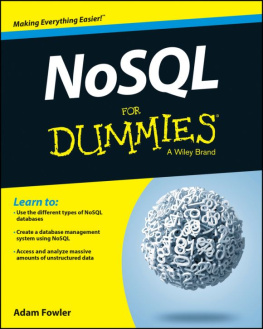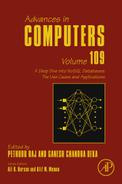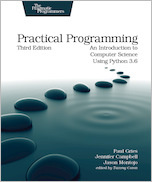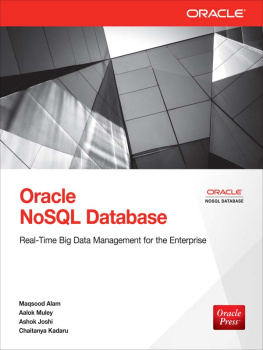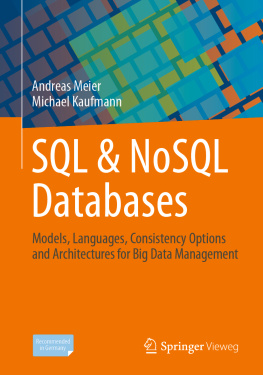
NoSQL For Dummies
Visit www.dummies.com/cheatsheet/nosql to view this book's cheat sheet.
- Table of Contents
- Deciding on Graph or Triple Stores
- Deciding on Triples or Quads
- Managing Triple Store Structures
Guide
Pages

NoSQL For Dummies
Published by: John Wiley & Sons, Inc., 111 River Street, Hoboken, NJ 07030-5774, www.wiley.com
Copyright 2015 by John Wiley & Sons, Inc., Hoboken, New Jersey
Media and software compilation copyright 2015 by John Wiley & Sons, Inc. All rights reserved.
Published simultaneously in Canada
No part of this publication may be reproduced, stored in a retrieval system or transmitted in any form or by any means, electronic, mechanical, photocopying, recording, scanning or otherwise, except as permitted under Sections 107 or 108 of the 1976 United States Copyright Act, without the prior written permission of the Publisher. Requests to the Publisher for permission should be addressed to the Permissions Department, John Wiley & Sons, Inc., 111 River Street, Hoboken, NJ 07030, (201) 748-6011, fax (201) 748-6008, or online at http://www.wiley.com/go/permissions .
Trademarks: Wiley, For Dummies, the Dummies Man logo, Dummies.com, Making Everything Easier, and related trade dress are trademarks or registered trademarks of John Wiley & Sons, Inc. and may not be used without written permission. All other trademarks are the property of their respective owners. John Wiley & Sons, Inc. is not associated with any product or vendor mentioned in this book.
LIMIT OF LIABILITY/DISCLAIMER OF WARRANTY: THE PUBLISHER AND THE AUTHOR MAKE NO REPRESENTATIONS OR WARRANTIES WITH RESPECT TO THE ACCURACY OR COMPLETENESS OF THE CONTENTS OF THIS WORK AND SPECIFICALLY DISCLAIM ALL WARRANTIES, INCLUDING WITHOUT LIMITATION WARRANTIES OF FITNESS FOR A PARTICULAR PURPOSE. NO WARRANTY MAY BE CREATED OR EXTENDED BY SALES OR PROMOTIONAL MATERIALS. THE ADVICE AND STRATEGIES CONTAINED HEREIN MAY NOT BE SUITABLE FOR EVERY SITUATION. THIS WORK IS SOLD WITH THE UNDERSTANDING THAT THE PUBLISHER IS NOT ENGAGED IN RENDERING LEGAL, ACCOUNTING, OR OTHER PROFESSIONAL SERVICES. IF PROFESSIONAL ASSISTANCE IS REQUIRED, THE SERVICES OF A COMPETENT PROFESSIONAL PERSON SHOULD BE SOUGHT. NEITHER THE PUBLISHER NOR THE AUTHOR SHALL BE LIABLE FOR DAMAGES ARISING HEREFROM. THE FACT THAT AN ORGANIZATION OR WEBSITE IS REFERRED TO IN THIS WORK AS A CITATION AND/OR A POTENTIAL SOURCE OF FURTHER INFORMATION DOES NOT MEAN THAT THE AUTHOR OR THE PUBLISHER ENDORSES THE INFORMATION THE ORGANIZATION OR WEBSITE MAY PROVIDE OR RECOMMENDATIONS IT MAY MAKE. FURTHER, READERS SHOULD BE AWARE THAT INTERNET WEBSITES LISTED IN THIS WORK MAY HAVE CHANGED OR DISAPPEARED BETWEEN WHEN THIS WORK WAS WRITTEN AND WHEN IT IS READ.
For general information on our other products and services, please contact our Customer Care Department within the U.S. at 877-762-2974, outside the U.S. at 317-572-3993, or fax 317-572-4002. For technical support, please visit www.wiley.com/techsupport .
Wiley publishes in a variety of print and electronic formats and by print-on-demand. Some material included with standard print versions of this book may not be included in e-books or in print-on-demand. If this book refers to media such as a CD or DVD that is not included in the version you purchased, you may download this material at http://booksupport.wiley.com . For more information about Wiley products, visit www.wiley.com .
Library of Congress Control Number: 2014954658
ISBN 978-1-118-90574-6 (pbk); ISBN 978-1-118-90562-3 (epub); ISBN 978-1-118-90578-4 (epdf)
Introduction
I love NoSQL both as a movement and as a technology. Its a fast-paced, constantly changing area. Barely a week goes by without a new NoSQL database being created to handle a specific real-life problem.
As a movement, NoSQL is interesting in that it started wholly independently of any commercial organization. In fact, it was the brainchild of interested individuals who grouped together and shared ideas. Some core ideas certainly came from large commercial organizations, including the Bigtable paper from Google and the key-value store paper from Amazon, but NoSQL was popularized as open source.
The normal process in software development is that several commercial companies form and compete with one another and gradually the field narrows. Then, once the remaining companies prove their worth, theyre gobbled up by big boys like Oracle, IBM, and Microsoft. Open-source alternatives appear only during the later phases of this cycle.
Thats not the case with NoSQL. Sure, there were a few early commercial players (very early in MarkLogics case way back in 2001). However, the majority of publicly available NoSQL products were created in the open before companies incorporated them into their commercial products.
This book encourages a practical approach to evaluating NoSQL as a set of technologies and products. The book tells you how to determine which ones might meet your needs and how select the most appropriate ones. This information enables you to spot business and technical problems that NoSQL databases can solve.
After reading this book, not only will you be able to identify which type of NoSQL database to use, but perhaps more importantly, youll know the questions to ask vendors about their software and services prior to purchasing one.
This book discusses NoSQL in terms of real-life, complex mission-critical applications. Understanding complex enterprise applications allows you to see the flaws and benefits of each NoSQL database, and within contexts similar to the ones you see in your workplace.
This book guides you through this exciting area of technology and highlights how you and your organization can achieve similar benefits to those described. I hope you enjoy the journey!
Foolish Assumptions
My main aim for the book is to expose many NoSQL databases and point out their common features and specific use cases.
My other aim is to point out that NoSQL databases are ready for the big time! I have gone to pains to point out where things can be configured to support this, or where gaps still exist in offerings.
I hope that large enterprises that have not yet widely adopted NoSQL will be reassured by this book. I also hope that it will act as a call to action to NoSQL database vendors in hardening their offerings to support the key needs of each business sector and use cases in such systems.
As this book is considering enterprise classes of problems, I have to be aware of things like long-term development plans, resilient systems, support, and availability of services.
Ive chosen to cover the following NoSQL databases (plus one search engine):
- Riak: A key-value store
- MongoDB: An aggregate (document) database that primarily stores JSON
- Apache Cassandra: A column store (Bigtable clone)
- Neo4j: A triple and graph store
- MarkLogic Server: Primarily stores XML documents, also JSON, binary, text. Also provides in memory column indexes, a triple store and a search engine
- Redis: An in-memory only key-value store
- Elasticsearch: An Open Source search engine used with many NoSQL databases
I was keen to give a background to a breadth of databases in this book. I also needed to make sure I wasnt covering the same subject multiple times. I decided to cover one database that primarily manages each data type (document, keys/values, column/tables, triple/graph).
Next page
